

William Stopford
2025 Chevrolet Corvette Z06 review
2 Months Ago
Kyle Fortune takes a ride in the next-generation Porsche 911 GT3 with the company's director for its GT track models, Andreas Preuninger.
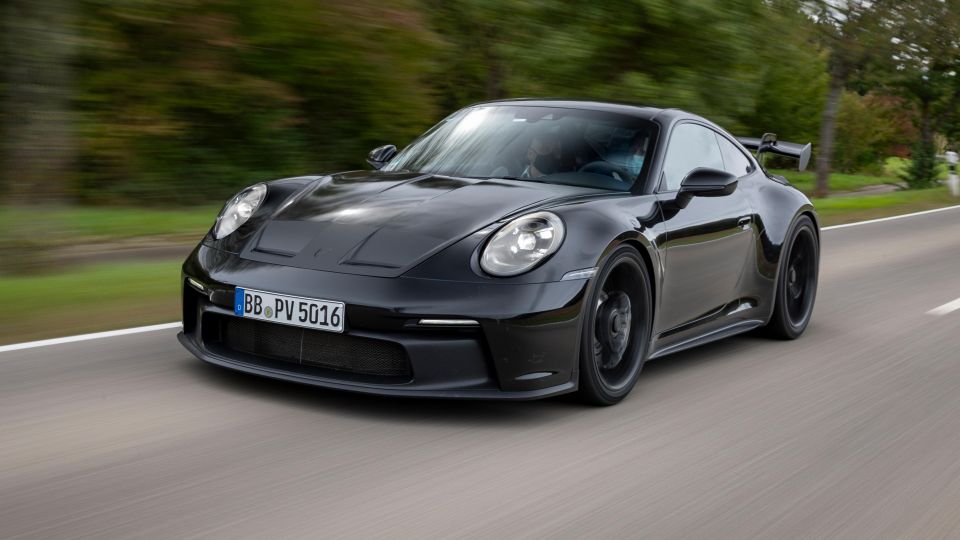


Contributor
New from
$229,100
excl. on-roads

Contributor
New from
$229,100
excl. on-roads


Contributor
New from
$229,100
excl. on-roads

Contributor
New from
$229,100
excl. on-roads
Quickly see how this car stacks up against its competition. Select any benchmark to see more details.
Where expert car reviews meet expert car buying – CarExpert gives you trusted advice, personalised service and real savings on your next new car.
We’ve seen plenty spy shots of Porsche’s ‘992’ 911 GT3, but today we’re getting a ride in it. Not only that, but Andreas Preuninger, Porsche’s director for GT models, is in the driver’s seat.
Development of the new GT3 began three years ago, and it’s all running to schedule. Preuninger admits the biggest hurdles he’s faced with the new GT3 haven’t been a global pandemic, but the ever-increasing legislative restrictions placed upon it getting what’s little short of a racing car, powered by a naturally-aspirated, high-revving 380kW 4.0-litre flat-six, certified for the road.
“The whole process of developing a car has gotten so complex,” says the GT boss.

As much as that evidently pains him, the engineer also seems to relish the challenge of the ever-tighter, moving goalposts. The GT3 is Porsche’s riposte to the legislators, a significant last stand to tradition, internal combustion, and the joy many of us still derive from driving.
Even so, Preuninger admits that does mean around 80 per cent of his GT department’s engineering expertise is dedicated to keeping the existing level of performance in ever-tougher conditions, with the other 20 per cent focused on ‘upping the ante’.
Like the eventual lap time we’ll all associate with it when it’s launched officially, that 20 per cent will be quantifiable, and that’s something any engineer likes.
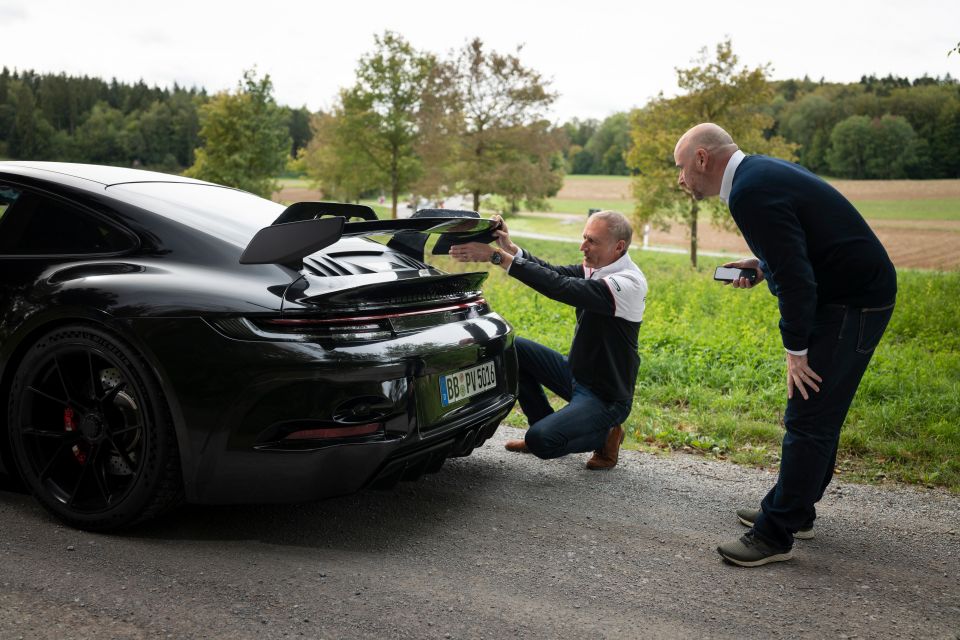
What’s more difficult to measure is the intangible elements that make all the GT3’s predecessor cars so appealing to the enthusiasts who buy it.
It’s also something Preuninger says is the biggest challenge. That being, ‘emotion’.
That is particularly applicable here too, because the 992 Carrera this GT3 is spun off has become more grown-up, mature, “in a positive way” highlights Preuninger.
“I don’t want the GT3 to be heavier. That was absolutely crucial. I have to be bigger because I’ve got the 992 body now, but I don’t want to carry more weight.”
And it doesn’t. Preuninger says the 992 GT3 is no heavier than the 991 GT3, that itself being quite an achievement.

That explains the composite bonnet on the GT3 as standard equipment, the rest of the weight loss being the usual GT3 fare – there are no rear seats, less sound deadening, thinner glass and lighter materials used wherever possible.
The rear axle is largely carried over from the 991, admits Preuninger, saying: “the rear axle is the multi-link system from the 991, which is carried over”.
“We have the rear-axle steering as well, which is newly calibrated. It was spot on with the 991, we didn’t want to touch too much. We just wanted to transfer this technology, the ideas, what it’s doing, on a new platform.”
The GT3 sits 25mm lower than a Carrera 2, and the jointing in the suspension is ball-mounted, Preuninger disliking any rubber bushings. The front axle is where the GT3 differs in its 992 application, with double wishbones being used on the front axle, a key revision with the GT3.
“Almost always, race cars have double wishbones. We were not sure if we could get this system into the 911 platform, and it was a big discussion and a big problem to solve. But we did it and it was worth it,” says Preuninger.
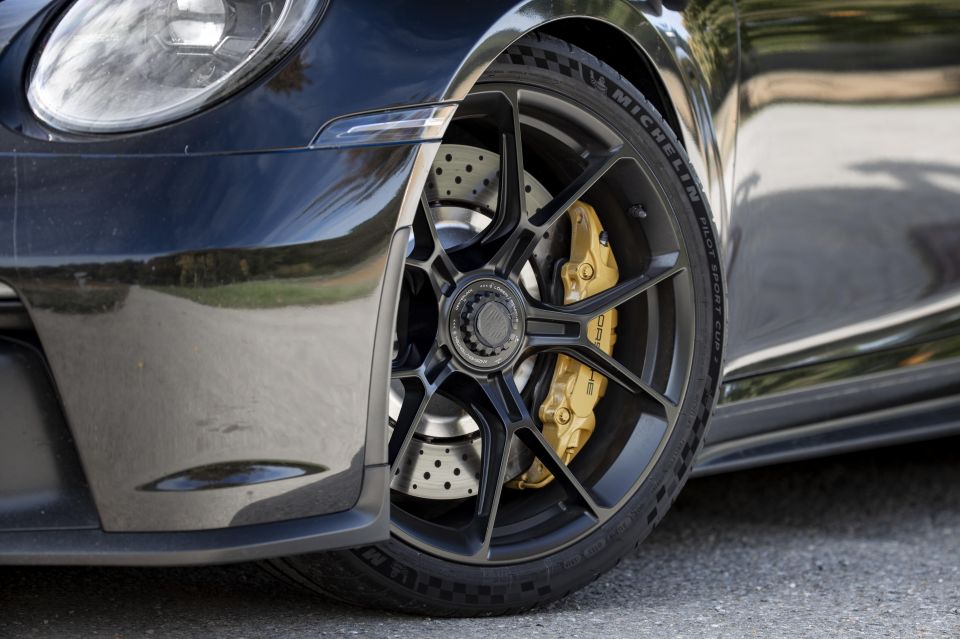

That new axle is quicker to react to bumps, there’s less resistance in the system and it’s stiffer and more stable under braking.
The front wheels are 20-inches and 9.5 inches wide, with the rear a 21-inch forged alloy, itself no heavier than the 20-inch wheel of the previous GT3. They’re 12 inches wide at the rear.
The front tyres are 255/35 ZR20s, with the rears 315/30 ZR21s, wearing Michelin Pilot Sport Cup 2s. As with all GT3s the wheels are centre locked, behind which new, larger 408mm front and 380mm rear brake discs reside.
Preuninger highlights the discs aren’t through drilled as they were previously, instead being pitted like those on Porsche’s race cars, beneficial to both longevity as well as performance. Porsche Ceramic Composite Brakes (PCCB) are offered optionally too, a carry-over from the predecessor GT3, with some minor revisions as is inevitable with the evolution.
Without a front strut having to take the force of the brakes, the dampers are significantly lighter over the previous GT3, too, though that switch did have an inevitable knock on to the steering.
“We had to start from scratch on the steering field. It took a long time to end up there we were with the McPherson system,” Preuninger says.
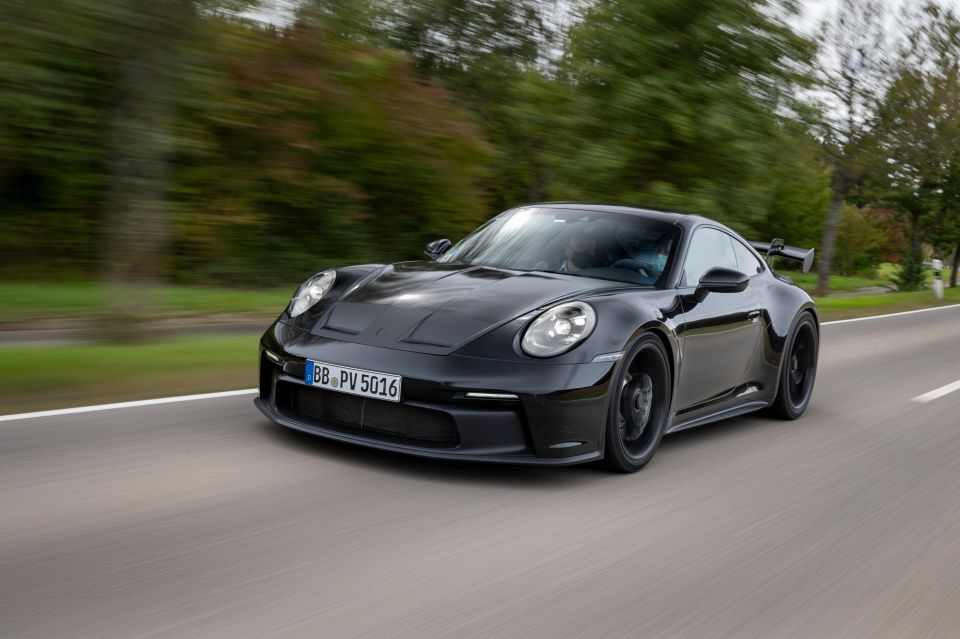
He adds too, the springs are stiffer, not quite to 991.2 RS levels, but about 25 per cent stiffer than the previous GT3.
That’s to the benefit of yaw and roll control, but not at the expense of comfort, with extensive damper tuning to help maintain ride comfort. The wishbones themselves are forged aluminium, with Preuninger saying they’re used on the 992 Cup car, joking: “we’re just lazy and didn’t want to construct two parts”.
The chassis, then, has seen significant changes over the 991 GT3, but the engine, admits Preuninger, is largely carried over from the 991.2 Speedster. That means a 4.0-litre naturally-aspirated flat-six, with any revisions to it here the result of it needing to pass future emissions and drive-by noise regulations.
Power will be the same 510hp(380kW) as the Speedster, a 10hp increase over the 991.2 GT3’s 500hp (373kW) output.
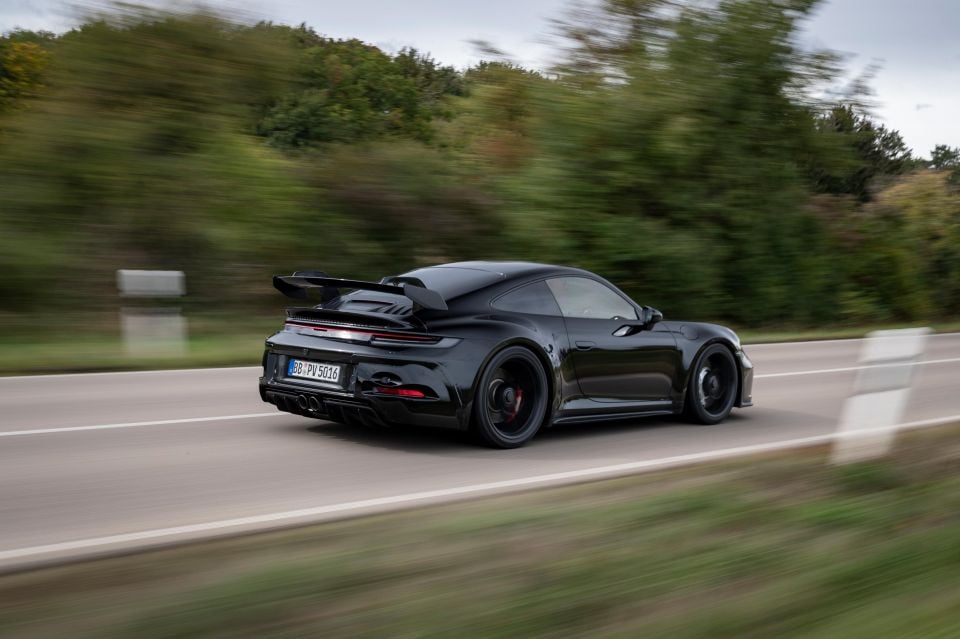
On the road, the engine tears around to 9000rpm with the same fervour as I recall from my last drive in a Speedster. The forces it transmits are memorable here, even from the wrong seat. Preuninger is clearly happy with its sound, saying: “it’s a typical GT3 howl, despite having a particulate filter and noise regulation”, and it’s difficult to deny the veracity of his claims, either.
It sounds great. He’s also enjoying the front axle’s turn-in which, even from the passenger side, feels quicker to react. The suspension too, rides with a deft suppleness that’s at odds with the taut body control.
This GT3 is a PDK, the seven-speed being a carry-over from the 991.2, as is the six-speed manual which will also be offered.
Both transmissions will be available on the standard, be-winged GT3, as well as the Touring which will come a few months later. Significantly, the PDK comes with a gear selector as well as paddle-shifters, which is a direct nod to Preuninger’s preference for driving the PDK using the stick.


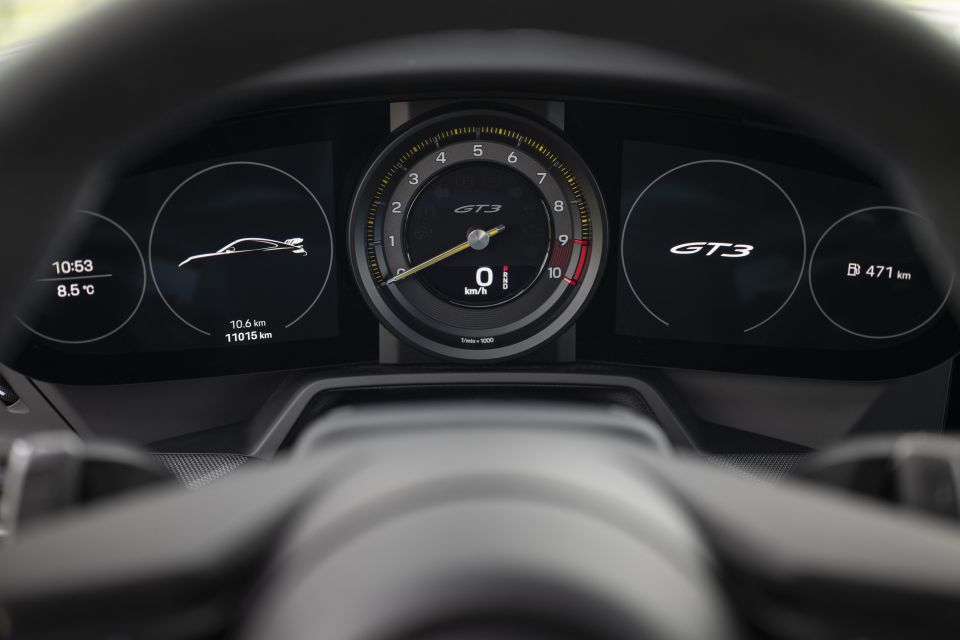
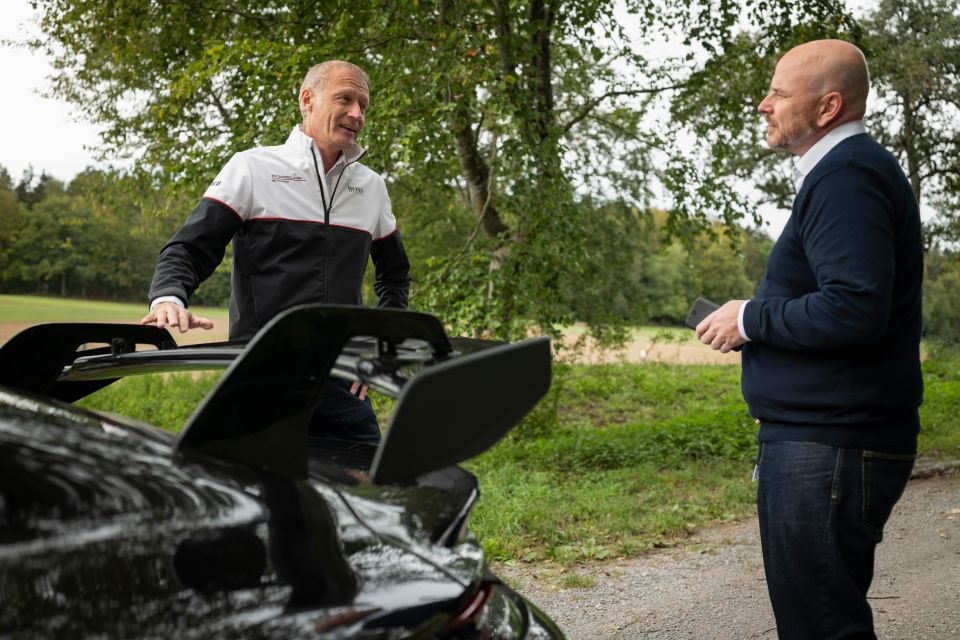
As memorable and forcefully that flat-six behind us is revealing its performance, it’s the whole package Preuninger describes as a leap forward.
Core to that is the aerodynamics, as well as those chassis revisions, to generate a greater whole. The greatest change with a number associated with it is a massive 50 per cent increase in downforce.
“The hung rear wing, the front end, the diffuser is a lot bigger and it does a lot more to the car – the combination of these are all good for the downforce. The wind tunnel work is extensive, but for me it’s important, the efficiency of the car is important,” says the engineer.
“We live in Germany, it has to be quick at acceleration even at higher speeds. There you need aerodynamic efficiency, that’s the point.”
“I want it to accelerate heavily until you see a three as the first of the triple digits. After that I don’t care,” laughs Preuninger.

That promise of good acceleration thanks to the lack of drag at three-figure speeds manifests as Preuninger takes on a section of de-restricted autobahn on our drive.
On the surrounding roads he knows well, the GT3 feels light and agile from the passenger seat. The seating position helps, the team here spending a great deal of time getting it right, with the instruments too being GT3-specific – the large rev-counter in one mode having two arcing lights on its sides that illuminate in blue as the revs rise.
The drive modes are reduced over the standard Carrera, so there’s Normal, Sport and Track modes, each configurable, within their own parameters, with the Wet mode of the Carrera not needed.
Preuninger wanted more simplicity from the drive systems and displays, and that’s what he’s achieved. The central screen remains from the Carrera, as does the climate control system, because Preuninger admits nobody ever deleted it anyway.
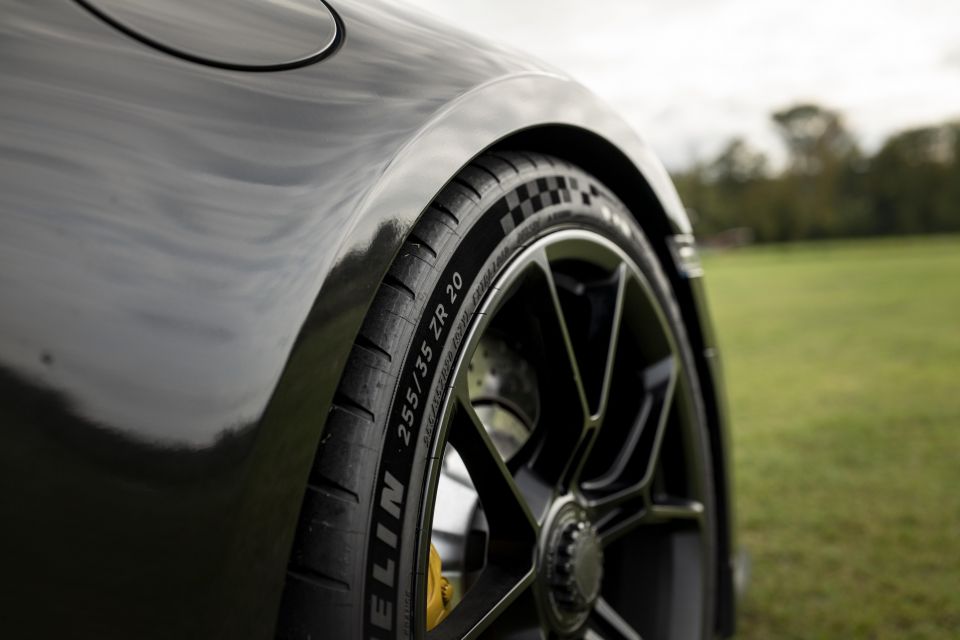

Visually it’ll turn heads, Preuninger says, adding that under all the cladding it’s: “beautiful.”
That’ll be apparent when it’s revealed early next year, but a few hours experiencing it in the hands of the man who’s responsible for it underlines that the GT3 remains true to what it’s always been.
A car full of contradictions, delivering greater performance allied with greater efficiency, more speed, yet all the engagement and excitement of those before it, it stable, riding beautifully yet managing its body with incredible poise and accuracy.
It should be quite a thing when we get to drive it, which we will next year.

Click on the images for the full gallery
MORE: 2021 Porsche 911 GT3 taking shape MORE: Porsche 911 news and reviews
Where expert car reviews meet expert car buying – CarExpert gives you trusted advice, personalised service and real savings on your next new car.


William Stopford
2 Months Ago
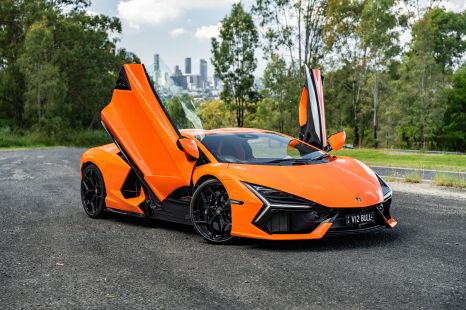

Alborz Fallah
2 Months Ago


James Wong
1 Month Ago


Paul Maric
25 Days Ago


Matt Campbell
15 Days Ago
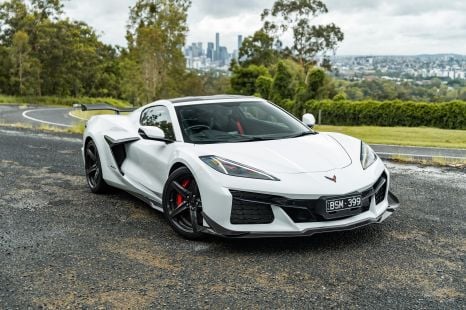

Damion Smy
13 Days Ago